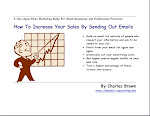How Filmaking Techniques Can Produce Better Copy and Websites
Posted by Charles Brown at Tuesday, January 16, 2007I recently started reading an interesting book that, on its surface, has nothing to do with copywriting or writing web content. And yet, I think this book could have incredible value to those who must write any form of business communication.
The book I’m talking about is “Beyond Bullet Points: Using Microsoft PowerPoint to Create Presentations That Inform, Motivate, and Inspire,” by Cliff Atkinson. This book is primarily designed to teach business people who to create better Microsoft PowerPoint presentations using a story-driven format.
Atkinson, who is a communications consultant for a long list of major U.S. corporations, confronts those typical, bland PowerPoint presentation we’ve all had to endure, that consist simply of long lists of bullet points. These kinds of presentations are not only marvelous cures for insomnia, they almost universally fail to get their point across (no pun intended).
Instead, Atkinson has adapted movie making and screenwriting techniques to tell a story with presentations (hopefully you are now beginning to see what this all has to do with copywriting and writing web content). He brings in the concepts of storyboarding and the three-act play structure to be used in communicating to audiences.
I see several applications here for copywriters and web content writers.
- The human mind tends to think in stories. Stories have been essential to our ability to understand new ideas and information. But even more importantly, stories make ideas more believable and persuade us to act on these ideas.
- Atkinson advocates beginning with the script or narrative text, just as a film company would begin creating a movie with the script. Many presentations (and websites) are created with the visual elements first. Instead, begin with the story or the message. A pretty website won’t sell, but the words written on that site can and should.
- Don’t try to communicate with raw data. People are not computers. Craft that data around human problems, needs, goals, changes and experiences. People relate to those things on an emotional level. And they are more likely to believe and act on this information when they can emotionally relate to it.
- Make the reader the star of the story. Either literally bring the person into the copy by addressing him or her in the second person, or tell a story about someone who is similar to the reader.
Think about all those commercials for weight loss products. They all use real people giving their testimonials. Potential customers for these products can relate to being overweight and unable to get the pounds off. Seeing someone like themselves who successfully lost weight with this product is strongly motivating.
Check out Atkinson’s book, Beyond Bullet Points. I think it has a lot of applications beyond just PowerPoint presentations.
freelance copywriter, ghost writer, web content writer, lawyer marketing, lawyer advertising, white papers
COPYRIGHT © 2007, Charles Brown

Labels: case studies, copywriting ideas



Hey Charles;
Great post. Here is a related article your readers might be interested in:
What Francis Ford Coppola Can Teach Us About Writing http://www.whitepapersource.com/writing/coppola-and-white-papers.html
Anonymous said...
5:57 PM
Thank you Michael. That is a very good article, and I think it just underscores the point that the human mind is very receptive to story structure as a form of communication.
Thanks, as always, for your input.
Charles Brown
Charles Brown said...
9:36 AM